| United States Embassy Tokyo, Japan |
 |
||
| Welcome to the U.S. Embassy in Tokyo. This site contains information on U.S. policy, public affairs, visas and consular services. |
|
|
||||||||||||||||||||||||||||||
|
The rice blast genome sequencing data can be found at the
following Web site:
http://www.genome.wi.mit.edu/annotation/fungi/magnaporthe/
Following is the text of the press release:
(begin text)
National Science Foundation
July 16, 2002
FIRST OF CROP KILLER'S GENOME SEQUENCE AVAILABLE
The first draft sequence of a worldwide crop-killing fungus genome has been completed under the joint National Science Foundation (NSF) and U.S. Department of Agriculture Microbial Genome Sequencing Project.
The fungus Magnaporthe grisea causes rice blast disease, which is estimated to destroy annually enough rice to feed more than 60 million people. The fungus was recently recognized by the Centers for Disease Control and Prevention as a potentially significant biological weapon that could be used for agricultural terrorism.
Certain strains of the fungus can attack domesticated grasses such as barley, wheat, pearl millet, and even turf grasses. Rice blast disease, once thought to be confined to only developing nations, has emerged in the United States over the past decade with the widespread introduction of rice as a crop in the South. In the Midwest, golf courses also have been devastated by the disease's attack on cool season grasses.
Previously, rice blast outbreaks were controlled through the application of costly and potentially hazardous chemicals. Genome sequencing will allow scientists to understand the interactions between the fungus and grasses, and identify the mechanisms that regulate infection of a host plant. This knowledge could help scientists discover new ways to prevent fungal crop infection and the spread of rice blast disease.
"This is an important first step toward understanding how this fungus attacks the rice plant," said Patrick Dennis, NSF's microbial genetics program director. "The scientific community needs this information to fill long-standing gaps in our understanding and to develop new strategies for controlling this destructive pathogen. This will be a springboard to new discoveries."
The research is continuing at North Carolina State University and the Whitehead Institute's Center for Genome Research in Massachusetts.
To view the rice blast genome sequencing data, see:
http://www.genome.wi.mit.edu/annotation/fungi/magnaporthe/
![]()